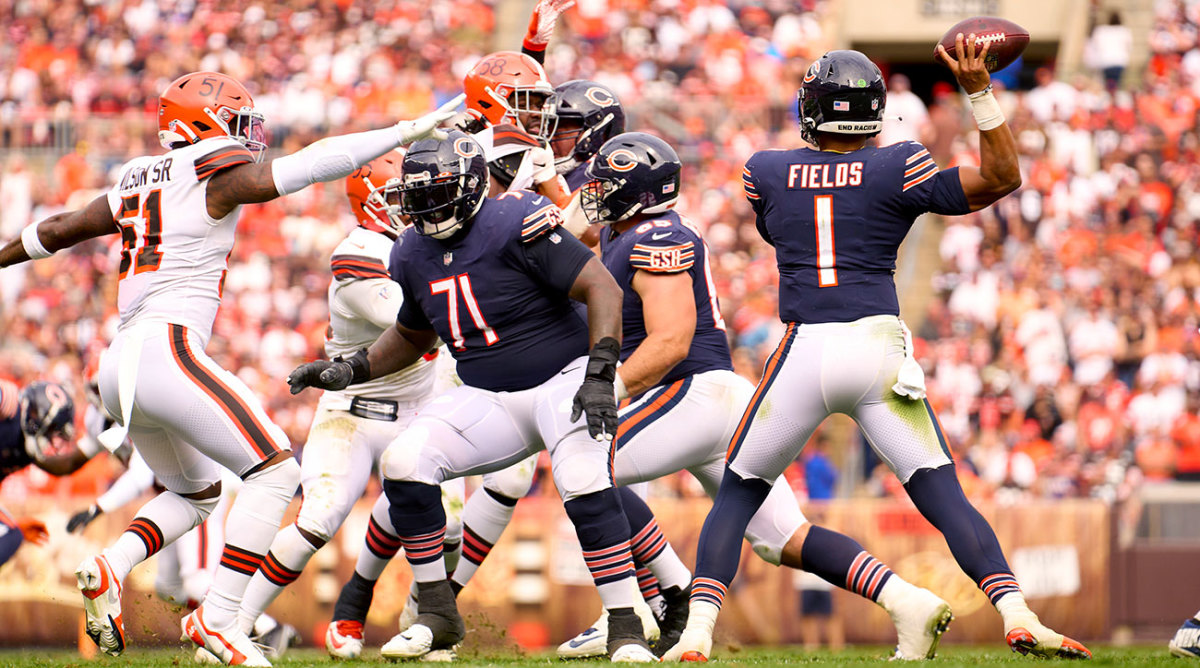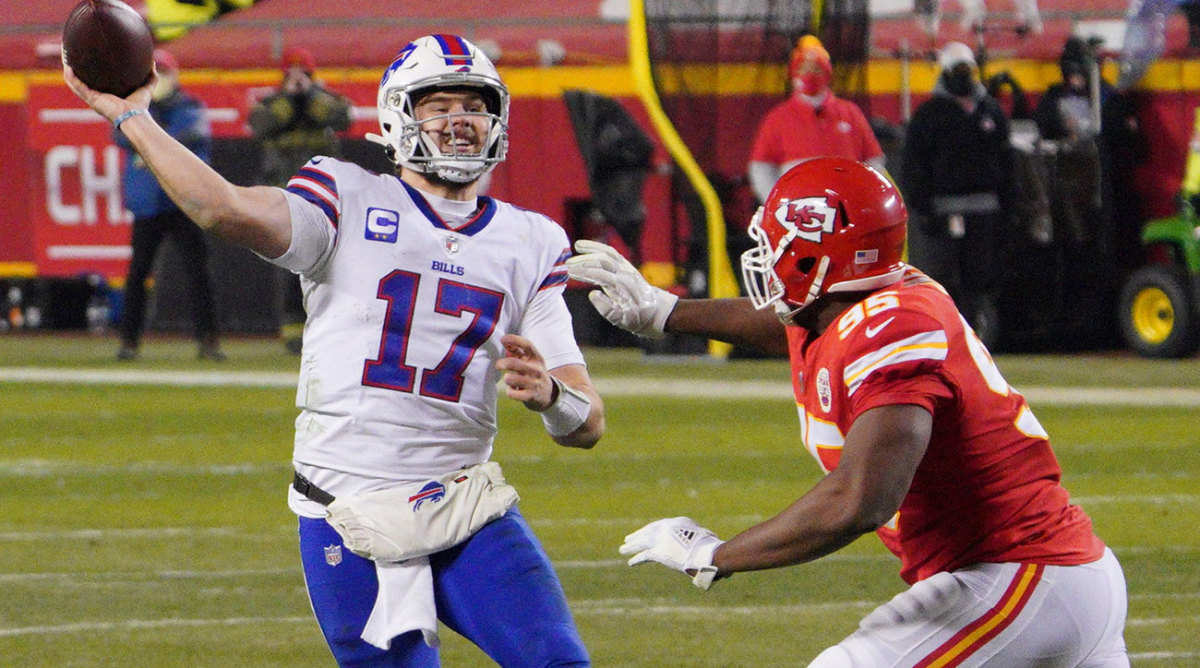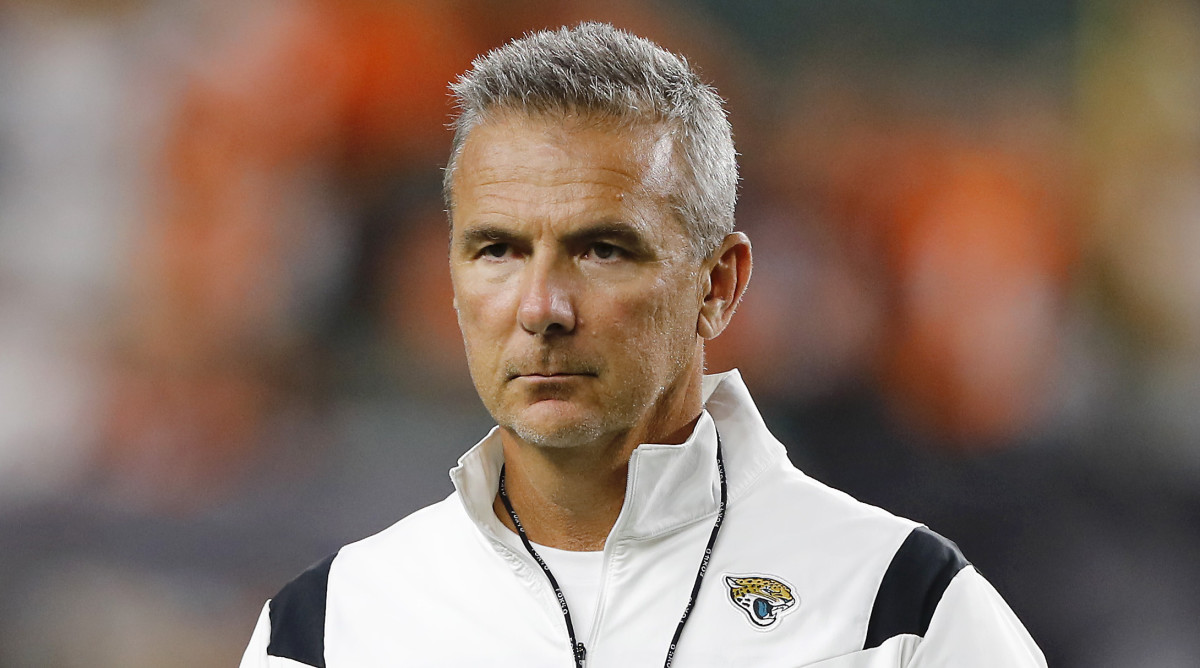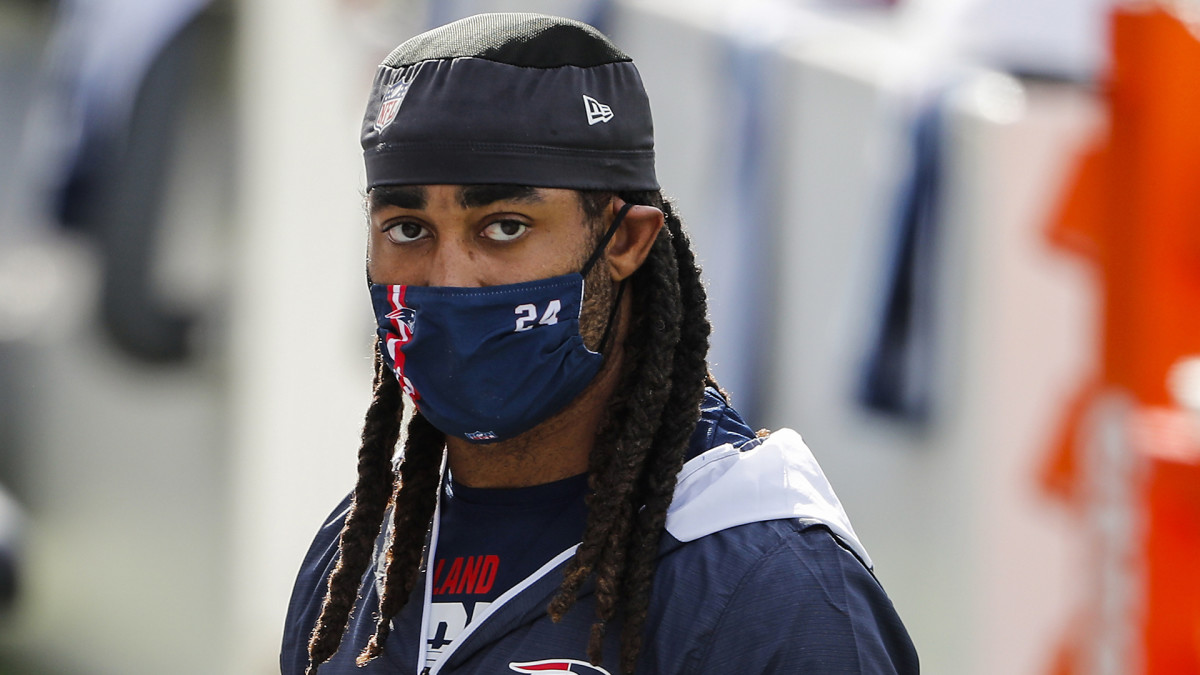GamePlan: Matt Nagy Discusses How Justin Fields Earned the Starting QB Job
There was a point in the Bears’ Week 3 game in Cleveland where it was clear, to the coaches at least, that first-round quarterback Justin Fields’s anticipation was just a tick behind where it needed to be. A Browns corner had moved tight to the line to press veteran burner Marquise Goodwin. The corner got on top of him, and did a decent job of disrupting his route, but Goodwin would eventually shake loose of the jam and the defender.
Unfortunately for Goodwin, and the team, Fields had given up on him by then, even though the receiver later wound up where he needed to be downfield, and the play went nowhere.
Not great. Still, not the end of the world. Fields is a rookie, after all, and this would stand as one of those teachable moments a quarterback can learn from as part of a trial-by-fire baptism into pro football. And besides, the coaches all figured Fields would eventually get this sort of thing, even if not quite in his first NFL start.
What they didn’t count on was it coming around the following week.

But there they were in the third quarter against the Lions, and there was Fields in a similar call, this time with the ball set to go to second-year phenom Darnell Mooney. Mooney was lined up to Fields’s right, and was even coming off the line with Detroit corner Bobby Price. Fields took a three-step drop, hitched and unleashed a bomb down the sideline, trusting that Mooney would get past Price and pushing Mooney farther outside to, in football terms, throw his receiver open, by putting the ball in a spot to influence Mooney away from Price.
That one ended up going for 32 yards, and set up Chicago’s third touchdown of the day, which made it 21–0. But more than just that, it illustrated that Fields was improving his command of the offense, and the program, pretty quickly. And the best part, as Fields’s coach Matt Nagy saw it, was that it very clearly wasn’t good enough for Fields.
“Justin was mad at himself for not leaving it more inside for him to be able to catch it for a touchdown,” Nagy told me, after wrapping up meetings Thursday night. “So now the next time we were able to get a chance to run a similar type play, Justin’s gonna wanna make it perfect, make it a 10-of-10 throw, and have Darnell score for a touchdown. That’s just a very simple example. No one may ever see it, but a 3-hitch timing throw, trusts his wideout to get open, threw him open.
“And it’s hard to sack a quarterback when you throw the ball on time, and he did that. That’s major growth for him in a simple way.”
Hitting on the big play a week after missing it is one thing. Wanting more out of the big play is another.
And the truth is, both are why Fields is now the Bears’ starter for good.
Four weeks in the books, and we’ve got a lot to get you ready for with the second weekend in October. Inside this week’s GamePlan, you’ll find …
• The weekend’s five biggest games, starting with a big rematch.
• What to look for from the Jaguars, in the aftermath of a rough week.
• More (poor) gambling advice!
• Reasoning for the short return the Patriots got for Stephon Gilmore.
But we’re starting with how Fields won over a coaching staff that for months insisted he wouldn’t.
Nagy swears there wasn’t some moment of clarity Sunday against the Lions—and no, that one throw didn’t give him religion on starting Fields as a rookie.
Getting here was a gradual burn, and the play we laid out is evidence of that, rather than any sort of flashpoint in the 11th pick’s climbing past Andy Dalton on the Bears’ depth chart. It shows, again, how far Fields has come on one hand, and how determined he is to nail down every detail he’s still missing on another. Which, as the coaches started to see it, should give them a lot to work with over the 13 weeks left on the 2021 schedule.
“What I can say, Albert, it’s that incremental improvement, that steady growth that you see,” Nagy said, as he took me through it. “You look at it and you say, Whether it’s questions that are asked in meetings throughout the week, whether it’s how he’s practicing, he’s been good. I think that’s probably one of the biggest things we noticed. He was practicing really well, albeit through the preseason and into the regular season, it was with the look team. And he was making some really good throws and good decisions.”
Really, that started right away, and at a base level—with Fields’s learning to call a play in the huddle, something he hadn’t really done before. The first step was just being able to relay the play call from the sideline to his teammates. The second was getting to the point where he was past just memorizing the verbiage and regurgitating it, and to an ability to command calls at a level where he was speaking to, not at, his teammates, and using the words to direct each guy where to go.
That last part, as you might imagine, is still a work in progress, but Fields has made strides.
From there, the Bears loaded him up on reps in their offense with the second team in camp—they kept him with the twos, rather than letting Nick Foles compete to be second string, because the twos get a lot more work than the threes—and played him a lot in the preseason. And the result was Fields’s winning the backup job, which was an implicit message that they’d feel comfortable playing him, since he was dressing over Foles.
After that, the season started and Fields settled into running the scout team. Which, once again, had a way of revealing more to the coaches, even if Fields spent those weeks commanding the Rams’ and Bengals’ offenses in practice, rather than the Bears’.
“Regardless of who you’re imitating or what you’re doing, you’re still doing quarterback stuff,” Nagy said. “You’re still able to drop back, you’re still working your footwork, you’re still working your timing, you’re still working your accuracy, you’re still working your leadership skills in and out of the huddle. ... That stuff does matter.”
Fields was also, Nagy continued, grasping the pro game better over that time—from little stuff like learning to manage the play clock in situational work, to the bigger task of diagnosing the defenses across from him.
“It happened fairly quickly for him, quicker than what I actually expected,” Nagy said. “I actually didn’t think it would happen that quick, so right there is a reason in itself [to start him]. He grew faster than we thought.”
If Dalton hadn’t gotten hurt in Week 3 against his old team, the Bengals, maybe we wouldn’t be here. Because if he didn’t get hurt, Fields wouldn’t have gotten the shot to play against, and show improvement in games with, the Browns and Lions. But really, it didn’t even take starting a game for Fields to start turning heads—that actually happened right away, when Fields came into the Cincinnati game.
And it wasn’t a highlight play that did that, either. It was actually the interception Fields threw to linebacker Logan Wilson, who he clearly didn’t see on an errant fourth-quarter throw. At that point, the Bengals had cut a 20–3 deficit to 20–10, and the pick deep in Chicago territory would wind up helping to make it a 20–17 game.
“You started feeling like, Man, here’s a rookie that just threw a pick backed up in our own territory, how he’s gonna react?” Nagy said. “He was probably the coolest guy on our sideline. And it was amazing, it was really neat to see, because all the players and all the coaches felt that. So there’s another example, you’re asking about growth, and asking about understand[ing] who he is, that’s a great example.”
He backed that up by scrambling 10 yards for a first down on third-and-9 three plays later, part of a four-minute drive that closed out the Bengals and ended with three kneel-downs.
“He was never rattled,” Nagy said. “He came back and said, Let’s go, let’s go finish this thing. That was his attitude, that was his mindset. Not everybody has that. It’s in his DNA.”
Surviving a nine-sack afternoon in his first start the next week—a game in which the Bears were bludgeoned by the Browns—only to produce in a big way the week after that against the Lions, is only more evidence of it.
And that’s why the Bears’ offensive coaches, after swearing Dalton was the starter for months, had something to talk about Monday. By Tuesday, Nagy, in conjunction with coordinator Bill Lazor and quarterbacks coach John DeFilippo, had made the decision to go with Fields permanently. Dalton got the first call with the news later that day, and the coaches called Fields after that.
Obviously, plenty went into the call. But a big part of it was pretty simple. The Bears had proven, now, that they could put together a plan to play with Fields, and win with Fields, without compromising what was best for the rest of the roster, which happens to be filled with playoff-tested veterans who wouldn’t be interested in any team’s three- or four-year plan. And if the momentum carries, he’ll continue to improve.
“We understand that, knowing who he is and how young he is, and he’s gonna get a bunch of experience and he’s only going to get better,” Nagy said. “Our job as coaches is to develop him, and make sure that we’re teaching him throughout the week. Bill Lazor and Flip have done an amazing job of teaching him how to be an NFL quarterback, not just in practice but also with the stuff you do off the field and how you handle all that. Everything it takes to be a great quarterback, they’ve done that with him.
“The other thing is this: Justin wants to be coached hard. And when you have somebody that wants to be coached hard, and they don’t take it personal, they just want to be great, because you’re trying to make them great; that’s infectious. It’s so great to have somebody who’s like that. … Justin wants as much of that as he can get.”
The hope is it’ll accelerate his development and help realize his potential.
That potential, of course, is obvious, and has been since well before he entered the NFL. And Nagy’s not going to deny what everyone knows—that he has an exceptionally gifted quarterback to work with. But for now, he’s not going to put all this on Fields’s shoulders, even if Fields has shown he can handle it. Which is why when you ask how good Fields could be in time, you’ll get some brake-tapping from his coach.
“I’m real careful when I answer that question,” Nagy said. “It’s that word expectation, what people expect. And Justin will tell you, in the end, he wants to be an unbelievable NFL quarterback that’s won a bunch of Super Bowls, if you keep it simple. But for us right now, honestly, he just wants to grow and learn, and be taught how to play this game, and let this game slow down so he can play fast.
“I don’t think any of our coaches, or myself, want to put what he can be on him. That’s not fair to him. But we do feel really good—and so excited. When you watch him, you know.”
And going forward, the rest of us will get to see a lot more of what the Bears have over these last five months.

FIVE STAR MATCHUPS
Ranking the five best games this weekend.
1) Bills at Chiefs (Sunday, 8:20 p.m. ET): The revenge angle is an obvious one here: The numbers don’t really show it, but Kansas City beat Buffalo pretty handily in last year’s AFC title game. But more important is what this could mean down the line for seeding, and which games are played at Arrowhead or Highmark Stadium in January. Also, it’s a good test to see where a red-hot Buffalo defense stands.
2) Browns at Chargers (Sunday, 4:05 p.m. ET): I considered putting this No. 1. It’s a great, great test for Northeast Ohio’s own Brandon Staley, who’s got the Chargers riding high and brimming with promise coming out of the first quarter of his first season in L.A. It’ll also be a good test of the improving Chargers offense is vs. the improving Browns defense, and specifically for the remade L.A. line going up against Myles Garrett and Cleveland’s front.
3) Broncos at Steelers (Sunday, 1 p.m. ET): Maybe not the sexiest matchup on the board, but it definitely has the feel of one that’ll either provide us all with a correction to the first four weeks of the season, or something more telling than that. This is as close to a must-win as you’ll get for a team this early—losing at home to fall to 1–4 would be a very tough pill for Pittsburgh to swallow. Meanwhile, the chance to stamp themselves as a real contender is there for the Broncos, a week after they missed out on a similar chance.
4) Bengals at Packers (Sunday, 1 p.m. ET): Turns out we may have all overreacted to Green Bay’s Week 1 loss to the Saints in Jacksonville. And that, once again, Week 1 really doesn’t mean much. But in Cincinnati’s case, it actually did foreshadow the way Joe Burrow was going to deliver late in games, the command he has over Zac Taylor’s offense and where he is coming off ACL surgery. Burrow vs. Aaron Rodgers should be a blast.
5) 49ers at Cardinals (Sunday, 4:25 p.m. ET): I still don’t know if we’re going to get Jimmy Garoppolo or Trey Lance. But I do know we’re getting intrigue from the 49ers’ quarterbacks, one way or the other. And their opponent’s quarterback, Kyler Murray, is now must-see TV every week.
Watch NFL games online all season long with fuboTV: Start with a 7-day free trial!

FOUR THINGS TO FOLLOW
Will the Jaguars show up for Urban Meyer? I’m interested to see what this looks like out of the gate—and if Jacksonville shows up with the same effort and attitude it did for that Thursday night game in Cincinnati. Because the effort and attitude have been there in Meyer’s first four games as Jacksonville’s coach, even if the wins haven’t, and that’s been apparent in talking to coaches who’ve faced the Jaguars. One Bengals coach said to me after their win over the Jaguars, “That’s not a bad team; they’re gonna win some games.” So are they as locked in given the week they had, and the trouble their coach created for them? To me, it’s a good test of where the foundation is in Meyer’s program, particularly with a Titans team that needs this one coming in.
Is the Patriots’ offensive line a problem? Over the years, it rarely has been, and a big reason why has been Dante Scarnecchia’s presence as its leader. The old line coach is now in his second year out and, frankly, the drop-off this year is glaring (and maybe exacerbated by co-line coach Cole Popovich’s choosing not to work this year rather than get vaccinated). And now, that group is beat up—with four starters’ having missed Wednesday and Thursday practice in Foxboro. So what will that look like against an undermanned but competitive Texans team Sunday? And can they keep Mac Jones from having to take the kind of beating he did against the Bucs? This is worth keeping an eye on, for sure.
Can Zach Wilson build on his Week 4 effort? In this week’s MAQB, we detailed the steps forward that the Jets’ rookie took in last week’s win over the Titans—and it was really more about his ability to make the routine plays than any of the theatrics that made him the kind of prospect worthy of the second pick. And with the team’s playing on national TV Sunday morning against an iffy Falcons team, the opportunity to build on it will be there for him. His ability to matters, as I see it, because he too often tried to play Superman earlier in the year, and having back-to-back weeks of progress in that area would mark a trend.
Will the Ravens keep the reins on Lamar Jackson? It’s no secret that the 2019 MVP is a little beat-up, so it makes sense that Baltimore has pulled back a little on his usage in the running game (28 carries the first two weeks, 14 carries the last two weeks). Will that continue against the Colts on Monday night? And is it going to be that way going forward? Given Baltimore’s injuries at tailback and receiver, it might be tempting for the coaches to, eventually, pull the ripcord on their best player. We’ll see if it happens this week or further down the line—or maybe they’ll just be more judicious as they proceed in general.
TWO BEST BETS
Season record: 2–6 (A .500 week feels like a win at this point, so I’ll take those Week 4 results.)
Panthers (-3.5) vs. Eagles: So after stubbing my toe in picking the Panthers to cover in Dallas last week (whoops!), I’m doubling down on Carolina. I still think this is a really good team, and if Christian McCaffrey winds up playing, I’ll feel even better about this.
49ers (+5.5) at Cardinals: I think this is nip-and-tuck all the way through, and that’s even if Garoppolo can’t play.

ONE BIG QUESTION
Why didn’t Stephon Gilmore go for more than a 2023 sixth-round pick?
I’ve gotten this question a lot, and I think there are three things to look at that explain, in full, why the Patriots couldn’t get more (and you can check out my column from Wednesday if you want to know why I believe they really blew their chance to over the last year).
One is age. Gilmore just turned 31. Corners generally don’t age all that gracefully once they get on the wrong side of 30.
Two is his injury situation. His quad’s healthy now, but how a player of Gilmore’s age will come off an injury is always a question.
Three is cap and contract. He’s got $5.8 million left in base salary for 2021, and this is the final year of his contract, meaning he’s a rental.
And if you put those through three factors together? Well, it’s exceedingly rare that players on the PUP list are dealt. In fact, the only recent example I could find was a 2019 trade that sent Kiko Alonso from the Dolphins to the Saints. And while Gilmore’s number, $5.8 million, doesn’t seem like all that much, there are just 13 teams league-wide that could afford to bring him in without moving money around first, and one of those (the Packers) would’ve been left with about $100,000 in space in the aftermath.
So if you’re another team, you’re most likely going to have to mortgage other contracts to bring Gilmore in, and push more money to what’ll be another relatively tight-cap year in 2022 (a big jump is coming in ’23); and you’ll be doing it for a 31-year-old coming off an injury, with 13 games left on his contract (in other words, what if he needs time to get his sea legs back?). That is a lot to sort through.
Which is where the Panthers were able to strike. Carolina had $18.6 million in space, second-most in the league, at the start of the week. They also have young corners, in the currently injured Jaycee Horn and new acquisition C.J. Henderson, on hand who will benefit from Gilmore’s presence. And if Gilmore plays well and leaves in March, he’ll likely fetch a 2023 fifth-round comp pick, which offsets the ’23 sixth-rounder Carolina traded for him.
If he stays? Well, then even better.
Add it up, and it’s easy to see why the Panthers did this. And just as easy to see why other teams that would’ve been interested if not for the cap implications—I’m told the Bills, Cowboys, Packers, Chiefs, Saints, 49ers and Buccaneers were in that category—stayed away.
